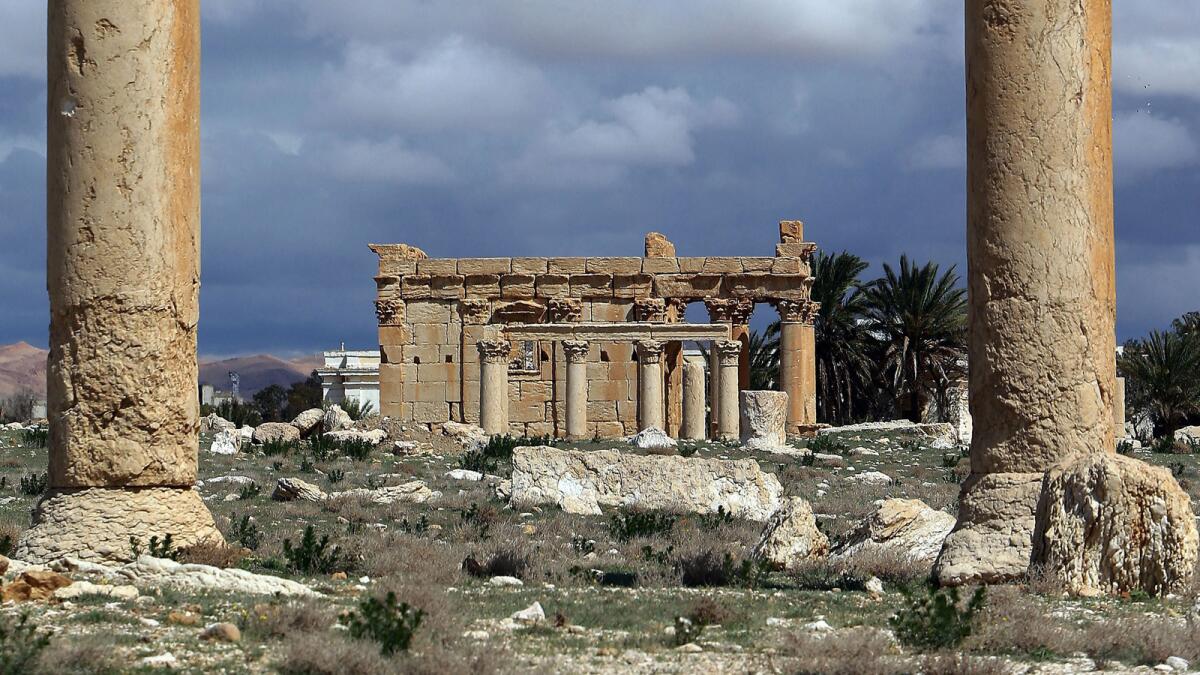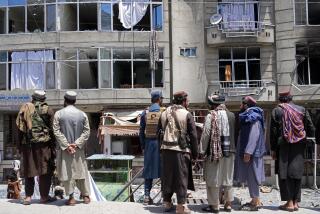Islamic State destroys temple at Palmyra ruins in Syria

A picture taken on March 14, 2014, shows the Temple of Baalshamin, seen between two Corinthian columns in the ancient oasis city of Palmyra, Syria.
- Share via
Reporting from BEIRUT — Islamic State militants have destroyed a temple at Syria’s ancient ruins of Palmyra, activists said Sunday, realizing the worst fears archaeologists had for the 2,000-year-old Roman-era city after the extremists seized it and beheaded a local scholar.
Palmyra, one of the Middle East’s most spectacular archaeological sites and a UNESCO World Heritage site, sits near the modern Syrian city of the same name. Activists said the militants used explosives to blow up the Baalshamin Temple on its grounds, the blast so powerful it also damaged some of the Roman columns around it.
The Britain-based Syrian Observatory for Human Rights said Sunday night that the temple was blown up a month ago. Turkey-based activist Osama Khatib, who is originally from Palmyra, however, said the temple was blown up Sunday. Both said the extremists used a large amount of explosives to destroy it.
The pro-opposition observatory group and Khatib relied on information from those still in Palmyra, and the discrepancy in their accounts could not be immediately reconciled, though such contradictory information is common in Syria’s civil war.
The fate of a nearby temple dedicated to the Semitic god Bel was not immediately known. Islamic State supporters on social media also did not immediately mention the Temple of Bel’s destruction.
The Sunni extremists, who have imposed a violent interpretation of Islamic law across their self-declared “caliphate” in territory they control in Syria and Iraq, claim ancient relics promote idolatry and say they are destroying them as part of a purge of paganism. However, they are also believed to sell off looted antiquities to fund their operations.
Khatib said the Baalshamin Temple is about 550 yards from Palmyra’s famous amphitheater, where the group killed more than 20 Syrian soldiers after the militants captured the historic town in May.
The temple dates to the 1st century and is dedicated to the Phoenician god of rain.
The head of UNESCO, Irina Bokova, said Friday that Islamic State extremists in Syria and Iraq are engaged in the “most brutal, systematic” destruction of ancient sites since World War II — a stark warning that came hours after militants demolished the St. Elian Monastery, which housed a 5th century tomb and was a major pilgrimage site. The monastery was in the town of Qaryatain in central Syria.
News of the temple’s destruction comes after relatives and witnesses said Wednesday that Khaled Asaad, an octogenarian antiquities scholar who devoted his life to understanding Palmyra, was beheaded by Islamic State militants.
ALSO:
Democrats defend Hillary Clinton’s use of private email server
Israel is abuzz over reports that attacks on Iran were planned but abandoned
Americans say train attacker ‘was ready to fight to the end. So were we.’
More to Read
Sign up for Essential California
The most important California stories and recommendations in your inbox every morning.
You may occasionally receive promotional content from the Los Angeles Times.












